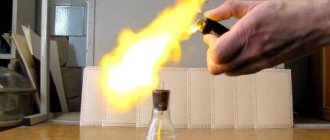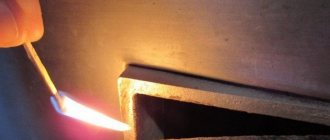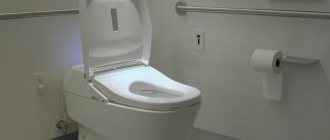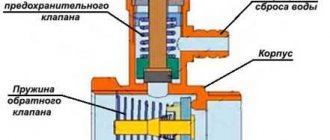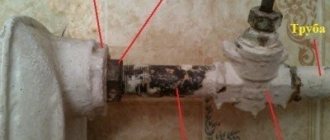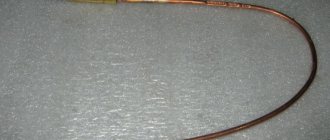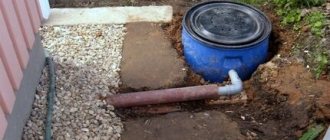Few people know, but it turns out that the speed of water flow in a home water supply can be controlled from a distance. To do this, instead of a conventional valve, a magnetic valve is installed. Let's figure out where such a useful device can be used, how it works, and what types of it exist. Read to the end and learn how to independently and competently purchase the necessary part.
Magnetic valve with control sensors Source aquacenter.es
Where is a solenoid valve needed?
A solenoid valve is one of the types of shut-off valves that can operate automatically, without human intervention. They provide a section of the pipeline that moves both any liquid and gaseous medium. And if a failure occurs at a given interval in the line, the valve blocks the flow.
The mechanism can also be programmed in the opposite direction. Under certain conditions, it will open the way to a liquid or gaseous medium. And to perform the required task, various sensors are programmed. It is they who supply the signal to the magnetic coil (solenoid).
Main applications of solenoid valve:
- Household sphere.
- Reclamation.
- Industry.
- Heating systems.
The basic purpose of the solenoid valve is to distribute water evenly, which most often occurs in doses. And a regular timer is set to open the system. And in the household sector, the mechanism is installed in public toilets, automatic showers and various washing systems. For example, car washes.
Solenoid valve with timer Source air-post.info
An electromagnetic solenoid with a timer is widely used for watering greenhouses and lawns, as well as garden plots and fields planted with cultivated plants. Such mechanisms are used in arid regions not only for land reclamation. They are installed in the water supply system for residential buildings. And each district of the city receives the scarce liquid according to the schedule.
But in heating systems, the valve performs protective functions. And its main task is to shut off the hot water supply in the event of a pipeline rupture. But the main purpose of the solenoid valve is to prevent a possible accident. And control sensors help him with this.
For a heating system, it is very important to constantly monitor the pressure inside the circuit and the temperature of the liquid medium. If these two parameters reach a critical value, the solenoid closes the shut-off valves in the pipeline until they return to normal.
The industry also widely uses automatic shut-off valve in many of its applications. They are also used in various production facilities where various components need to be mixed. And they serve as a kind of dispensers.
Watering the lawn using a solenoid valve Source magazun.com
See also: Catalog of companies that specialize in engineering systems (heating, water supply, sewerage and others) and related work
Criterias of choice
If a homeowner needs to purchase a drain valve with a mesh for installation on a water supply system, you need to rely on the selection criteria and technical parameters of the product:
- indicators of nominal, test and operating closing pressure;
- tightness class;
- conditional throughput indicators;
- diameter of the landing part.
The documentation supplied with the pumping system or water pump contains information about the technical requirements for the drain valve and its modifications.
You need to purchase new products that were manufactured no more than 5 years ago. If they have been stored in warehouses for a long time, the operation of the part may be unproductive.
How does a solenoid valve work?
The advantage of the electromagnetic solenoid over other shut-off valves is its complete automaticity. Without human intervention, a passage through a pipeline is opened or closed for the flow of liquid or gas. And this is done by the electromagnetic field that arises in the electric coil. It is this that sets the shutter mechanism in motion.
Solenoid valve design:
- Metal or polymer body.
- Induction coil with core.
- Sealant made of polymers or technological rubber.
- Functional elements in the form of a plunger, spring and steel rod.
Metal housings are used in systems with high internal temperatures. Circuits with cold liquids are equipped with plastic devices. The enclosure is always extremely sealed to protect the induction coil.
But the device itself is useless. Therefore, it always works in tandem with a control sensor. And the most popular of them are a timer and a temperature sensor. It is they who, when triggered, supply current to the coil. As a result, the electromagnetic field in it either closes the valve or opens it.
Installation features
Stages of installing a drain valve
To install a drain valve yourself, you need to familiarize yourself with the installation features. Basic moments:
- Before installing the part, you need to check whether the system is equipped with a filter for rough water purification. If not, during operation the valve will constantly clog and quickly fail.
- The drain valve is mounted on the pressure line below the downhole adapter (if it is used).
- During installation, the trajectory of the working fluid in the pipeline is taken into account. For this purpose, a direction arrow is indicated on the body of the pumping equipment. If you neglect this rule and install the device incorrectly, it will not fail, but it will not be able to perform its task.
- In the system, the temperature of the working environment must be less than the permissible temperature on the part.
The service life of the most budget valves with a mesh and rubber seal does not exceed 3 months. To prevent this problem, it is recommended to choose equipment with only a metal seat and a metal-to-metal seal.
Types of magnetic valves
There are models that can only open the passage to the flow. After the magnetic field in the coil disappears, the spring will return the rod to its place. Such devices are installed in irrigation systems. Models that only cut off the flow of liquid are mounted in heating circuits. Such mechanisms are called one-way ones because they are the simplest.
But there are also bistable samples that perform both functions. Usually equipped with various sensors. At the command of some, movement opens to the flow. Others, as a rule, monitor various disturbances in the system and give a signal to close the valve.
Such models come in two and even three-way types. In the first case, they prevent the reverse flow of water flow. In the second, they can mix liquids with different temperatures.
Solenoids can use either AC or DC current. To connect to pipes, use either a thread or a flange. The control element can also be used in different ways. The piston may move inside the locking mechanism. There are also models with membranes or spools.
Magnetic valve design Source banbas-nn.com
What is the siphon effect
The valve for draining the washing machine into the sewer allows you to increase the service life of the machine and improves the quality of washing. The effect of its installation is due to the design features of the unit.
Waste water is discharged from the washing machine into the drainage system, for which there is a special hose on the back side. It is connected to a pipe; if necessary, its length can be increased to 3 meters. The principle of draining is simple - at a certain stage of the wash, a pump is turned on, which pumps dirty water out of the drum and directs it into the sewer. According to the rules, the end of the hose should be at a height of 60-90 cm from the floor. A bend occurs that prevents wastewater from entering the machine.
However, many owners do not read the instructions carefully and make mistakes when connecting the hose. Self-draining of water occurs when it begins to spontaneously flow out of the tank. The automatic machine starts filling the tank, but the water continues to drain. This effect creates a lot of problems:
- washing time increases;
- electricity consumption for heating water increases;
- water consumption increases;
- severe wear of parts and components of the device occurs.
In addition to self-draining, it is possible to draw dirty water from the hose back into the tank. This is especially noticeable if an extended drain channel is used, in which a lot of waste water remains. To cut off wastewater from the drum cavity, the washing machine is connected to the sewer system through a check valve. It prevents the reverse flow of waste water, allowing waste water to flow freely in the right direction. If a cut-off is installed when connecting, you don’t have to worry about the height of the end of the hose above the floor. Let's take a closer look at this device.
Nuances of selection and installation
When purchasing the type of electromagnetic shut-off valve, you need to pay attention to two points. Initially, you need to study the parameters of the pipeline. So that the inlet and outlet openings of the valve completely coincide with the diameter of the line. Otherwise, the water flow may slow down. And this is fraught with an increase in pressure and temperature in the system.
It is equally important to study the specification. The manufacturer must indicate for which systems its products are intended. The description gives the minimum and maximum permissible values for the internal temperature, as well as pressure and flow rate.
It is always necessary to take into account the conditions and chemical composition of the product that will move through the pipeline. For example, acid will corrode the brass body of the device. And too hot water can destroy the plastic shell.
Installation of a magnetic valve in a heating system Source master-vodoved.ru
Operating principle and device
The operating principle of the drain device is as follows:
- Shutting off the pumping equipment leads to a drop in pressure in the pipeline. When the mark reaches 0.6-0.7 bar, the drain valve is activated and naturally drains the remaining liquid from the pipeline back into the well.
- After starting the pumping equipment, the pressure in the system rises to 1.5 bar, and the valve closes.
This principle of operation effectively prevents unwanted stagnation of the water column in the pipeline system.
Drain valve design
The automatic device is a small device in a brass body, the internal cavity is equipped with a plastic valve. When the pressure in the line drops, the valve drain hole opens. Stainless steel is usually used to make the body. Main structural elements:
- A composite type of housing, the parts of which are connected using threads.
- A locking mechanism consisting of two movable spool plates mounted on a special rod and a sealing gasket.
- Plastic valve installed at the outlet of the throughput connector.
The drain valve must be installed at a depth below the freezing level of the soil. The optimal installation depth is 5 meters.
When purchasing a device, you should not give preference to the most budget-friendly ones, since, as a rule, low-quality materials with a short service life are used in production.
Briefly about the main thing
All you need to know about the magnetic valve is that it requires electricity and various control equipment to operate automatically. For example, a timer programmed for a certain time will send a signal to the induction coil. The latter drives the plunger on the valve, built into a regular water supply.
The raised rod will open a passage for water, and a strictly calculated portion of liquid will fall into the flower pot. And the amount of required moisture will be measured by a special meter. He will then send his signal to the same coil. And this time the electromagnetic field pushes the rod into place, blocking the flow of water.
DIY water solenoid valve installation
According to the type of connection to the pipeline there are:
- flanged valves;
- threaded valves.
When installing and using solenoid valves, you need to remember the following important points:
- Before you begin installing a solenoid device for water with your own hands, it is recommended to carry out preparatory work. This includes pipe cleaning and marking.
- The location for installing the valve must be in a visible place so that it can be easily accessed. The compact size of solenoid valves simplifies this task.
- It is strictly forbidden to install the device if the electromagnetic coil functions as a lever.
- Installation and dismantling of the device is carried out in a de-energized state.
- It is advisable that the water supply system be equipped with a dirt filter. This will prevent the product from clogging with foreign particles.
- The solenoid valve must not be subject to stress from the weight of the pipes.
- There are special arrows on the surface of the valve that indicate the direction of movement of the medium. Installation is carried out according to them.
- If installation is carried out in an open area, the device should be protected with special insulating materials.
- It is recommended to use FUM tape to seal the connection between the valve and the pipe.
- The device is connected to the electrical network using a cable. It must be flexible and have a core cross-section of at least 1 mm.
Shut-off and control valves should be selected and installed according to calculations made in advance. It is necessary to use one or another type of valve depending on the type of pipeline and the medium transported through it.
Questions and answers about drain valve UNIPUMP 1″ 24340
And who can tell how it works? Where to put it?
+ Alexander Karpov in the tee. in the main line from the well at a depth of 1700-2000 mm from the ground level (where the water does not freeze), when the pump is disconnected from the network, the consumer tap opens, thereby the pressure in the system drops, the tap opens and the water flows back into the well. You can safely close the dacha for the winter and go home))) In the spring, come, close the consumer tap, turn on the pump, pressure will build up in the system and the valve will close. but it must all be connected with automation; without automation, the pump can go into another world.
Source
How to choose the right toilet parts
If elements of the drain system fail, it is important to choose the correct option that will correspond to the factory configuration. The units may differ in the material they are made of. Products made of bronze and brass are considered the highest quality and most durable. However, they are characterized by high cost.
The repair kit for the toilet is selected based on the model of the tank. Important parameters are the location of the inlet, its size, the diameter of the drain opening and the overall dimensions of the device, which must fit freely into the tank. The flush mechanism for a toilet can be represented by a single design or consist of separate (drain and fill) devices. The second option significantly facilitates and simplifies the process of replacing products.
If elements of the drain mechanism break down, the repair kit is selected based on the model of the tank
When choosing a valve, you should pay attention to the quality of the product. The mechanism must operate under its own weight. It is necessary that all its components are movable, move smoothly and unhindered. There should be no jamming of any kind.
When choosing a drain mechanism, you should carefully inspect the elements. They must have a solid body, free from chips and cracks, and the correct geometric shape, which will contribute to efficient and uninterrupted operation. Spare parts for toilets made from high-quality material have a high cost.
Seals and gaskets should be purchased from silicone. Such products, unlike rubber ones, are characterized by strength, reliability and durability. Elements are checked for compression and bending. They should not be deformed or cracked.
Helpful advice! The best performance and strength properties are provided by sealing elements, in the manufacture of which rubber is added to enhance elasticity.
New mechanism parts must be of high quality, without chips or cracks.
Purpose and scope of application
The main task that the drainage device must perform is to protect the autonomous water supply system from freezing of liquid flows that are transported through the pipeline.
The most common critical situation is a sudden cessation of operation of a pumping station or submersible, surface pump during the onset of cold weather. As a result, the pipeline freezes, this leads to a violation of its tightness and integrity, and breakdown is inevitable. Installing a drainage device allows you to prevent these unpleasant phenomena. In addition, the miniature-sized part prevents the consequences caused by hydraulic shock. The use of a drain part makes the system more productive and efficient, and the service life of the entire system is extended.
Models and prices
The names, appearance, country of origin and prices of some valve models are presented in the table below.
| Name | Manufacturer country | Price, rub |
| Kludi 1042705-00 | Germany | 500 |
| Vitra A45137EXP | Türkiye | 595 |
| Elghansa siphon WBT12 | Germany | 1000 |
| Viega 103385 | Germany | 780 |
| Elghansa siphon WBT12-bronze | Germany | 1360 |
| Kludi 1042405-00 | Germany | 1800 |
Automatic drain valve for well ISK K1/2
Valve material: 1) valve body - brass, 2) spring and ball - stainless steel.
Nominal diameter (DN) : 1/2″ HP (male thread)
Price of a set with a brass tee (1″x½″x1″): 2600 rub.
Maintaining and maintaining your own water supply system is a rather troublesome and difficult process. This is always felt during cold periods, when the system fails and urgently needs to be repaired. Today there is a solution that will allow you to avoid certain manipulations to drain water from the system, for example, when installing with a well adapter, draining from the system when using a well as a source of water supply. This has an automatic drain valve that allows you to solve the problem of draining water without your participation. How does an automatic winter well valve work?
The operating mechanism of this device is very simple. When you disconnect the pumping equipment from the network, or also open a water tap, for example, the pressure in the system tends to zero, thus when the pressure drops below 0.5 bar, the drain valve opens due to a special spring and a round ball that moves away from pressure seat and thereby releases water from the line. When the pumping equipment is turned on, the pressure in the system increases (more than 1 bar) and this valve closes again.
The “correct” water drainage system in winter
Diary entry created by Andrey-AA, 02/08/10 .633,
We are talking about draining water from water supply pipes in winter when leaving for several days or more.
The goal is to prevent water in pipes from freezing. In my opinion, there are two “correct” options and one “old-fashioned” one (at the bottom there are links to two more correct options): 1. “Simple” - a crane in a caisson or in the area of an adapter with a 2-meter lever - a rod brought up to opening and closing the tap.
2. “Electric” - an electric faucet or valve at the location indicated above, controlled from the home. In any of the options, the device is placed below the soil freezing depth. Naturally - above the check valve. 3. “Dedovsky” - just above the submersible pump, a small hole with a diameter of about 1 mm is made in the hose or pipe. This will not greatly affect the operation of the pump and the pressure, but the water will slowly flow back into the well each time. The disadvantage is the need to knock out air during a new cycle of operation. Let's consider the advantages and disadvantages of both “correct” options.
1. Simple, reliable and cheap, non-volatile, but inconvenient, because...
it must be closed and opened through an open caisson or well. Imagine how to do this in winter. However, perhaps there are “tricky” options that bring the control rod to the surface. Or you can do this with a cable, pulling the tap with a spring. In any case, you will get a “homemade” product with all the “flowing in” and “flowing out”. 2. The electric method has 2 options - a solenoid valve and a valve/faucet with a servo drive. The advantages of electric are convenience, because drainage is performed “by pressing a button in the house” or even completely automatically according to some criterion (for example, the temperature in the house is +10 degrees). This makes it possible for any adult household member, including women and musicians, to perform this important operation. Another advantage is that this option can be done for you by well construction specialists (but they don’t want to do it, because they can only sing one song - a banal tap for draining by climbing into a caisson). Disadvantages - unknown durability, volatility, high price. About choice.
Personally, I choose the electric method for my Obedient House. Why? Let's go through its shortcomings. A. Durability. Quite high-quality valves are available for sale, including ones specifically designed for draining water from tanks. B. The energy independence of this valve, with the correct construction of all subsystems, is not very significant, because it should be normally closed (i.e., consume energy only for a couple of minutes during the drain itself), and if it is necessary to drain water when the network is turned off, I personally and, perhaps, other people have a backup power system (PSS) , which can easily provide 2-minute power supply to this valve for draining. And, in the absence of a PSA, you can find a valve with a power supply voltage of 12 Volts DC and, in this case, an auto-battery can be used as a backup power supply. However, if you do not have a PSA, then you probably rarely have your network turned off. Then the issue with the valve supply voltage is not relevant - select
220V. B. Price. The concept of “high price” is relative. Even in comparison with the 1st option, it is actually unknown, because the labor costs for this “simple homemade product” are unknown. Well, compared to the cost of a well, its arrangement, water treatment, etc. - so generally small. Selection Criteria
electric valve for draining water from water supply systems (in priority order): 1. High reliability in conditions of high humidity. The service life is at least 5-10 years. I think that the protection class of the electric valve should be no worse than IP-65. 2. The valve must have a hole for water - at least 5 mm - so that it does not become “overgrown” with “scale” from hard water for a long time and quickly drains the water. In particular, based on this indicator, I removed valves for irrigation systems from consideration. 3. Also, the valve must have zero minimum water pressure to open, otherwise all the water will not drain out, i.e. it should be called "direct action". Valves from washing machines do not meet this parameter (I don’t know - from all of them or not). 4. Convenient power supply - either
220V (if there is a backup power system, or rare network outages), or constant 12 Volts - apparently, it will not be difficult to find an adapter for power supply, and when the electricity is turned off, an auto-battery. 5 Price. Everyone decides for themselves how much their comfort costs. Specific options:
At the current microsecond, I have not made the final choice and, moreover, I have no experience in operating an electric magnet.
valves in water drainage systems, however, I think it’s right to show the reader the valves that are under my consideration: - WaterValve SM55632; — Danfoss EV250B (not all! Suitable only with zero minimum pressure); — Wexon Sirai L113, L133, D144; All are solenoid, normally closed, direct acting (operate at zero pressure), the holes are quite large. Notes:
1. I would place the water drain control button, along with the heating cable control, next to the water inlet into the house - so that I can hear how the water is drained and be sure of it.
What is needed here is a button (released - the power is turned off), and not a toggle switch - so as not to forget one day to remove the voltage from the valve. Before draining the water, the pump and heating cable must be turned off and it is better to open any water tap so that low pressure does not create in the system and the water drains more easily. 2. Later he invented/discovered two more drainage methods - hydro-pneumatic, calling it “vacuum” and hydraulic (“drainage”). On this topic you can
Automatic drain valve for well 1″ Unipump 24340
Price per pack of 6 pcs: 1,866 rub. Price per one. product: 311 rub. 353 rub.
Write off up to 141 rubles. bonuses We will award 3 bonuses
- In your city: 3 pcs. In stock: 8 pcs.
- Pickup: tomorrow, after 09:00, from 1 store
- By courier: tomorrow, from 190 rub.
The automatic drain valve Unipump 24340 is designed to automatically drain residual water into the well in winter in order to prevent freezing of water in the pressure line. When the pressure drops to 0.6-0.7 bar, the valve opens and water drains from the main line into the well. When the pump starts and the pressure rises to 1.5 bar, the valve closes again. Made of brass.
Connecting thread – 1″.
Technical characteristics of automatic drain valve for well UNIPUMP 24340
- *The manufacturer reserves the right to change the characteristics, appearance, configuration of the product and the place of its production without notifying the dealer. The information provided is not a public offer
Found an error in the description?
- Russia is the birthplace of the brand
- China - country of production

